Key Insights
- Despite a challenging year, Harmony remains focused on protocol development, growing the ecosystem, improving developer tools, and pursuing a cross-chain future.
- The Harmony team committed to 0% minting and will strategically deploy Harmony’s treasury to select partners using burning mechanisms to remove depegged assets from circulation.
- Key infrastructure integrations like stage sync and Elastic RPC were released in the quarter, improving network stability and security and reducing latency and operational overhead.
- Harmony’s bridge restoration strategy includes the upcoming launch of LayerZero as the Ethereum bridge revitalizing interoperability, focusing on vault and security audits of both trustless Bitcoin and Ethereum bridges.
- The effects of DFK’s departure and the Horizon Bridge exploit are still being felt this quarter as overall network metrics declined.

*In the previous quarter, network usage and contract metrics were primarily sourced from Flipside. Messari has since switched over to Covalent for network usage metrics on a go-forward basis. The two data providers use different methodologies, resulting in material changes to select metrics QoQ.
Primer on Harmony
Harmony is an Ethereum Virtual Machine (EVM)-compatible Effective Proof-of-Stake (EPoS) smart contract platform for decentralized applications. It uses the Fast Byzantine Fault Tolerance (FBFT) consensus mechanism and a random state sharding technique that separates a chain into segments. Each segment processes transactions and stores data in parallel, thus increasing transaction throughput and speed. Harmony also utilizes a Verifiable Random Function (VRF) and Verifiable Delay Function (VDF) to ensure secured randomness when validators are assigned to shards, preventing the possibility of a “single shard attack.” Harmony achieves 2-second transaction finality with 1,000 nodes, a quarter of which are across four shards.
Introduction
The crypto market has been reeling from a tumultuous year as participants continue to breathe in the bearish sentiment lingering for a second consecutive quarter. Despite the overall market shedding approximately 55% in market capitalization YTD, the total crypto market has since stabilized, declining by around 4% QoQ.
Harmony’s network usage and overall financial performance also declined for the second quarter, in line with the broader market. However, this quarter’s decline was catalyzed by the Horizon Bridge hack that occurred on June 23, 2022. This incident resulted in the bridge being drained of $100 million in assets from the Ethereum and BNB chains, ultimately depegging bridged (ONE) assets. This breach only exacerbated the decrease in network activity following DeFi Kingdom’s decision to launch on an Avalanche subnet in Q2.
Harmony’s core team recently committed to 0% minting to prevent token dilution by using funds from the Harmony treasury to facilitate the recovery process. In October, the team will allocate funds on an ongoing basis starting to strategic partners, using burning mechanisms to remove depegged assets from circulation.
Performance Analysis
Network and Financial Overview

Harmony endured another challenging quarter following the departure of DeFi Kingdoms in late April and the bridge exploit at the end of June. The macro backdrop combined with Q2’s events proved to be problematic for Harmony in Q3. Network usage, defined by daily active addresses and transactions, declined by 74% and 70%, respectively.
Daily user metrics were at their lowest in 12 months, down 87% from their peak in Q1 2022. Similarly, daily transactions were down 88% from their peak in Q4 2021. Despite the culmination of events, the circulating market cap grew (8.4%) for the first time this year during Q3.
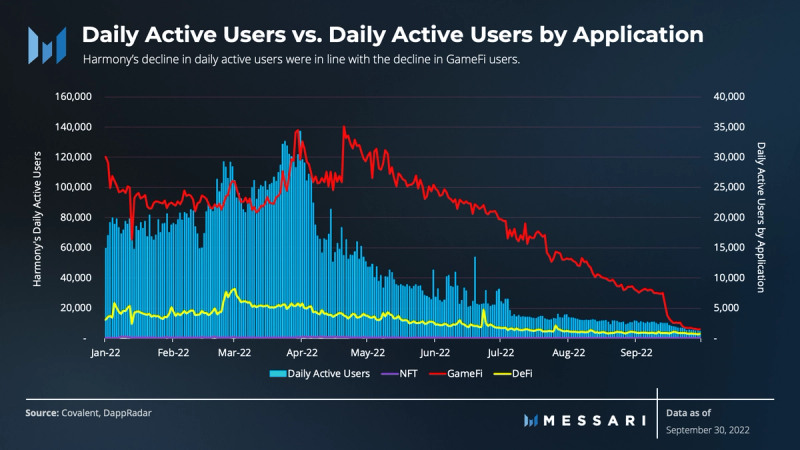
The decline in daily average users (-34,000) QoQ coincided with the overall decline in GameFi and DeFi users. DeFi Kingdoms (DFK), Harmony’s most successful game, announced its launch on an Avalanche subnet in April and has since created downward pressure on Harmony’s active user base.

The events that unfolded in Q2 caused daily transactions to fall by 70% to 28 million in Q3, their lowest in over a year. Declining transactions and suppressed price (-69%) of ONE reduced average transaction fees by 47% QoQ, also their lowest since Q4 2021.
Although cheaper transaction fees are a net positive for current users and applications, they result from reduced network usage. This declining network usage is not unique to Harmony, as many Layer-1 protocols also experienced a drop in activity during the bear market.
The gradual increase in daily average transaction fees in July was consistent with Harmony’s decision to increase gas fees to ward off sophisticated arbitrage bots. However, the spike in mid-August was tied directly to ONE’s price fluctuation, despite a decline in transactions during the same period. Harmony’s fully diluted market cap exceeded $400 million on average over a five-day period, breaking the mark for the first time this quarter.
Average daily transactions during the last two weeks of September were 70% fewer than the two weeks prior. The steep decline in transaction activity dramatically reduced average transaction fees.
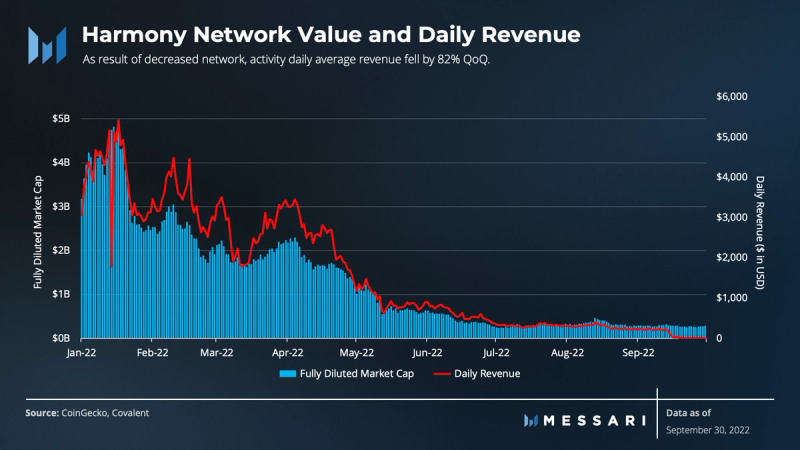
There were 721,000 fewer transactions in Q3, while transaction fees were down by nearly half, putting pressure on daily revenues. Daily average revenue drastically fell (-82%) to $240, compared to $1,350 in Q2.
The decline in revenue is in line with fewer transactions, lower fees, and declining prices QoQ. All three metrics play a role because, simply put, revenue is derived from the gas consumed to facilitate a transaction and the market price of the native asset.
As part of the Horizon Bridge recovery plan, the protocol intends to add a hard fork to route all transaction fees to a community-managed account. The newly routed fees will be directed to a community-owned multisig account, which will support ongoing protocol development and reimburse the off-peg-wrapped bridge tokens.
Ecosystem and Development Overview
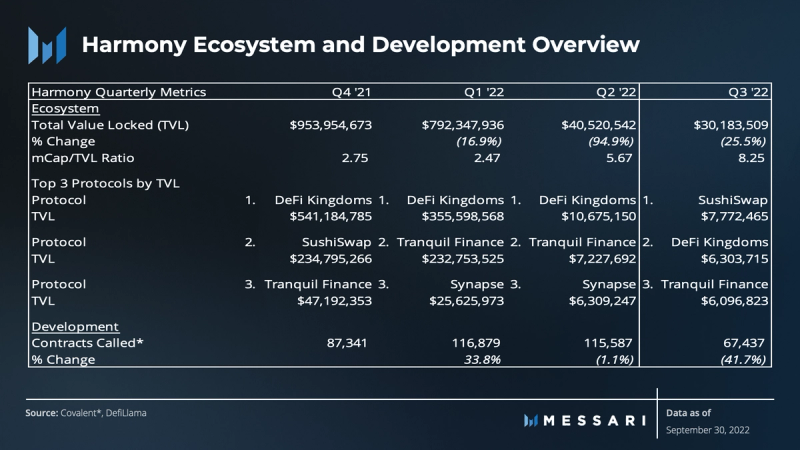
Harmony’s ecosystem and development continued to experience obstacles as the crypto market fell by about 4% QoQ. Total value locked (TVL) was down across its largest protocols, as well as unique contracts called, in the quarter. DeFi and GameFi are currently the predominant applications on Harmony, as NFTs represent less than 2% of the activity. The decline in unique contracts called QoQ signals a decline in the breadth of decentralized applications, consistent with the decrease in network usage and activity.

For three subsequent quarters, Harmony’s TVL fell, shedding 26% in Q3. Despite the substantial drop in TVL after the Horizon Bridge hack in Q2, TVL managed to improve slightly as the quarter closed. The average amount of TVL denominated in ONE fell by 58% QoQ to 1.7 billion, consistent with the decline in active users.
The bridge hack caused some assets to depeg as malicious actors drained funds from the Ethereum and BNB sides of the bridge. Users who had funds bridged essentially held unbacked assets, which caused disruptions to Harmony DeFi and applications like Aave.

The top protocols in the quarter represented over 65% of Harmony’s TVL, suggesting a large majority of Harmony’s user activity takes place on a few protocols. DeFi Kingdom’s (DFK) TVL was flipped by SushiSwap in Q3 — the first time its standing was challenged since Q4 2021 — which was unsurprising due to DFK’s decision to launch a subnet on Avalanche.
DeFi Kingdoms recently announced its plans to retire DFK Serendale on Harmony indefinitely and move over to Klaytn, an L1 public blockchain geared towards gaming and the metaverse. Because DFK was effectively the largest native application on mainnet, the recent news is a substantial blow to the ecosystem as GameFi participants, DFK ones in particular, have been the dominant user base on Harmony.
DFK represented 21% of Harmony’s TVL in Q3 and had been the leading application on its platform in the last year. At its peak, DFK made up over half (57%) of Harmony’s TVL.
Tranquil Finance, Harmony’s third largest application by TVL, fell 16% QoQ. The decline in TVL was likely a result of paused borrowings caused by the Horizon Bridge hack, capping utility. Tranquil Finance’s price oracle struggled to deliver accurate prices due to the depegged assets, disrupting Harmony’s top lending protocol.
Aave was also impacted by the hack. Aave governance voted to freeze all reserves on the Aave V3 deployment on Harmony, preventing users from depositing or borrowing assets. However, the repayment of debts, liquidations, and withdrawals was still allowed.
Staking and Decentralization Overview
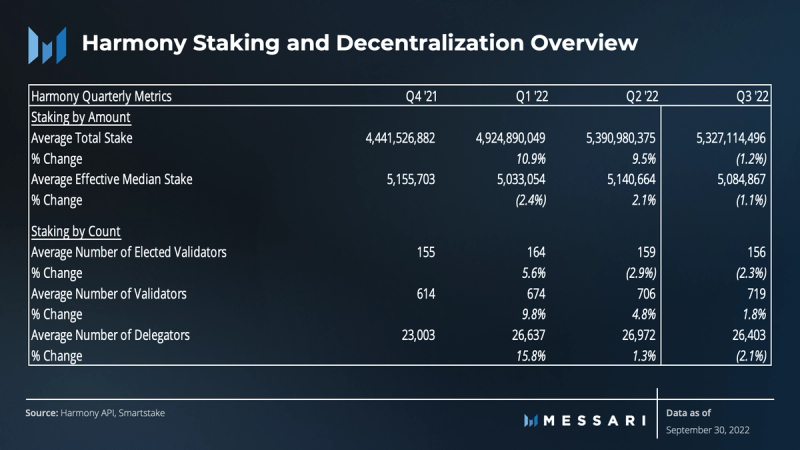
Harmony differentiates its staking mechanism from others by using Effective Proof-of-Stake (EPoS). Staking rewards are based on the effective median stake of validators. The validators’ rewards are capped by this mechanism, incentivizing them to spin up a new validator to maximize rewards. The mechanism is designed to promote further decentralization and to prevent “overstaking.” In turn, delegators are encouraged to delegate to validators below the median stake to capture optimal rewards.
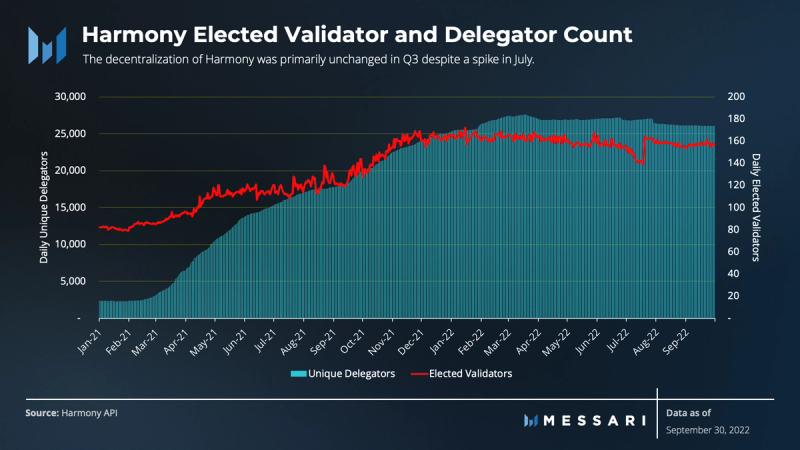
Harmony’s average number of elected validators and delegators was down slightly (-2%) QoQ, seeing levels from Q4 2021. However, there was a period of 12 days in July where daily elected validators fell below 150 before stabilizing thereafter.
Validators are elected based on their effective stake, which is based on the median stake of the entire network. In short, the brief decline in elected validators was likely a result of a validator’s effective stake falling below the required threshold.

The average total staked and the average effective median stake were both relatively flat (-1%) in Q3. In contrast, the average annual staking yield grew slightly (1.2%) to 8.2% QoQ.
However, the spike in staking yield from 8% to almost 10% in late July was due to a temporary shift in engaged stake. The engaged stake is the percentage of the total stake and total circulating supply. On July 28, the total staked dropped by 12% momentarily before stabilizing.
The network’s decentralization remains primarily unchanged in the quarter, signaling a robust and stable network despite the events that unfolded in Q2.
Qualitative Analysis
Key Events
Horizon Bridge Hack Post-Mortem
Since the Horizon Bridge hack that took place on Jun. 23, 2022, community members, contributors, partners, and the Harmony team have collaborated to support users and partners impacted by the exploit. Approximately $100 million was drained in the incident, depegging the bridged assets. There are approximately 65,000 wallets across 14 different asset types that fell victim to the breach.
The malicious actors executed the exploit by taking control of the 2-of-5 multisig wallet securing the bridge. The exploiter then transferred the stolen funds to various wallets, eventually routing the majority of funds through the cryptocurrency mixer Tornado Cash.
This bridge hack was not a result of inadequate smart contracts or an unsecure consensus layer, but rather, the result of a vulnerable 2-of-5 multisig wallet. Following the incident, the Harmony team updated the bridge to a 4-of-5 multisig.
Recovery One
A group of community members formed the Recovery One Foundation to engage in formal discussions with validators, developers, partners, and community members. They aimed to generate meaningful ideas, solutions, and proposals surrounding the bridge incident and represent depegged tokenholders.
Through collaboration, Recovery One (R1) and close partners launched the recovery governance token (rONE). rONE enabled a proper governance system where depegged tokenholders could vote on proposals. After multiple iterations, R1 formed the Community Proposal, recommending that the Harmony team prioritize partners and the allocation of recovery funds. On September 28, R1 announced the vote passed unanimously for adopting the Community Proposal.
Harmony’s Recovery Plan
The Harmony team has committed to 0% minting to preserve existing tokenomics and avoid the inflationary impact of increasing supply. The team plans to take a balanced approach, allocating treasury funds toward the network, team, and recovery.
The team will allocate a monthly budget to close partners using burning mechanisms designed to remove depegged assets from circulation. Treasury funds will be regularly deployed over a four-year period while the team assesses the efficacy of removing depegged assets.
Organizational Structure
Several Harmony core team members departed in the quarter, which is somewhat common in the current market environment. The most notable organizational change occurred when Rongjian Lan, Harmony’s Chief Technology Officer, stepped down from his role to become a technical advisor.
Infrastructure Integrations and Updates
Staged Sync
The recent implementation eliminates the requirement of a full sync of all data from a node to be considered up-to-date with transactions. Instead, a full sync node only needs to pull the data required. As a result, the network became more stable, as CPU, RAM, and bandwidth usage improved.
Elastic RPC Full Integration
Harmony released Elastic RPC in Q2 to upgrade its existing public RPC, routing half of shard zero’s traffic. Now, 100% of the traffic is routed through the Elastic RPC infrastructure, increasing transaction speeds and improving reliability. The Elastic RPC infrastructure accommodates more traffic and allows partners and end users to retrieve the full history of the Harmony blockchain with minimal overhead.
MAP Protocol
A strategic cross-chain partnership between Harmony and MAP Protocol was announced in July. The two will work closely using MAP’s omnichain network infrastructure to build a trustless bridge connecting EVM and non-EVM chains.
IBC Bridge with Cosmos (Testnet)
Datachain has been building a bridge between Cosmos and Harmony since the beginning of the year. The bridge operates between IBC-enabled blockchains and Harmony, enabling trustless interoperability between the two ecosystems. The feature will improve utility and community expansion, increasing cross-chain use cases.
Because the successful completion of the IBC bridge is limited to testnet, the Datachain team’s next step is to build it out in the mainnet environment.
Harmony V4.3.12
The release is recommended for validator and RPC-providing nodes, including a fix to epoch sync and an updated reference to the head block.
Ecosystem Integrations and Partnerships
Stably USDS Stablecoin
Stably launched a USD-backed and regulatory-compliant non-algorithmic stablecoin on Harmony. USDS is a multichain, fiat-backed stablecoin and also Harmony’s first natively issued stablecoin. Users from over 200 countries worldwide can mint and redeem the Harmony USDS, now available on over 10 other blockchains.
Harmony Naming Service (HNS)
SonicSwap.IO launched its Harmony Name Service domains platform, allowing users to purchase a decentralized name with ONE.
NFT Integration
MADNFT, a multi-chain NFT launchpad and marketplace, announced the successful integration of NFT collections on Harmony. This will allow users to import NFTs from across the Harmony NFT ecosystem.
Kitchen Data Systems (KDS)
The partnership merges real-world retail with blockchain. This will enable KDS to integrate merchandise, creative digital content, and users’ ability to mint NFT access passes.
Harmony Grants Program
Harmony announced in Q2 that inbound grant applications would be paused. It would, however, continue funding previously selected grantees meeting their milestones. The decision was made in an effort to reduce operational costs amid the market downturn.
Given the events that unfolded this year, it became clear that onboarding developers, applications, and users are absolutely critical to growing the ecosystem. Improving the existing grant due diligence process and funding strategic projects that bring the most value to Harmony will be of the utmost importance.
Roadmap
Bridge Restoration Strategy
Harmony earmarked Q4 2022 to launch LayerZero as the Ethereum Bridge. The cross-chain bridge has been halted since the bridge heist, limiting interoperability and utility. The partnership aims to instill confidence in the community and provide a secure bridge to revitalize interoperability. In addition, development has continued on both trustless Ethereum and Bitcoin Bridges with vault and key security audits taking priority.
GetBlock Block Explorer
Harmony granted funding to the GetBlock team in Q3 to build an explorer for Harmony’s ONE and HRC20, HRC721, and HRC115 tokens. Harmony’s new GetBlock Explorer is slated to be unveiled in Q4 2022.
1Wallet Launch
As 1Wallet’s beta testing is finalized, Harmony anticipates launching its flagship wallet at San Francisco Blockchain Week in early November. 1Wallet is an open-source, non-custodial wallet allowing users to store private keys on their mobile devices. Through the use of smart contracts, users can send messages, create multisig group chats, send tokens and NFTs, and authorize wallet access.
Horizon Bridge Recovery Plan
The Harmony team will begin working with partners in Q4 to remove depegged assets from circulation, demonstrate their commitment to the community, and continue building a sustainable platform with the appropriate tools for developers.
Starting an initial two-week campaign in October, they plan to allocate $50,000 each to Tranquil Finance, Recovery One Foundation, and Modulo. Each partner will be tasked with developing a mechanism to burn depegged assets. The team will continue to allocate funds as it assesses the efficacy of these mechanisms.
Protocol Development
The Harmony team is excited about implementing many technical improvements, which they’ll continue working on through the coming quarters.
Leader Rotation
By rotating the responsibility through different validators, leader rotation can improve the protocol’s security. A leader node will require more CPU resources and uptime. However, this implementation will produce greater block rewards, meant to encourage validators to upgrade their node and reinforce their infrastructure. Testnet testing is slated to take place in Q4.
Cross-Chain Communication
The first test for cross-shard communication will be released in Q4. The feature enables smart contracts on different shards to communicate the state of each independently.
Closing Summary
The entire crypto community has been confronted by various challenges throughout 2022. Mounting regulations and the difficult macroeconomic environment applied downward pressure on crypto, forcing protocols to revert back to their fundamentals and build. The Horizon Bridge exploit, one of many bridge hacks this year, caused the Harmony team to reallocate their resources in order to bring stability back to the platform.
While the broader market continues to gain footing and focus on building, Harmony must remain transparent, following through on its commitment to the Horizon Bridge recovery plan, and delivering on its roadmap. By establishing a strong foundation, the Harmony team can incentivize new application developers to build the next DeFi Kingdoms on Harmony.
Let us know what you loved about the report, and what may be missing, or share any other feedback by filling out this short form.
This report was commissioned by Harmony, a member of Protocol Services. All content was produced independently by the author(s) and does not necessarily reflect the opinions of Messari, Inc. or the organization that requested the report. Paid membership in Protocol Services does not influence editorial decisions or content. Author(s) may hold cryptocurrencies named in this report. Crypto projects can commission independent research through Protocol Services. For more details or to join the program, contact ps@messari.io. This report is meant for informational purposes only. It is not meant to serve as investment advice. You should conduct your own research, and consult an independent financial, tax, or legal advisor before making any investment decisions. The past performance of any asset is not indicative of future results. Please see our Terms of Use for more information.



















